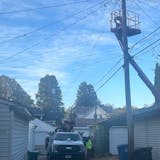Infinity Beatty-Metcalfe’s graduation from Hennepin Healthcare’s paramedic trainee program on Friday may have been destiny, but it was a delayed one for the 31-year-old.
She pushed herself after growing up in foster care to become an emergency medical technician (EMT) at 19. But Beatty-Metcalfe burned out from the intensity and frequency of ambulance runs in St. Louis. She had been inspired after witnessing the heroism of paramedics who brought a baby born prematurely to a hospital by helicopter. But paramedic training seemed impossible while working to pay bills and starting a family.
“That’s a lot of balls to balance,” Beatty-Metcalfe said.
Her struggle is exactly why Hennepin Healthcare’s emergency medical services (EMS) division created its trainee program in 2020, paying EMTs to work part time while completing accelerated paramedic training.
Too few individuals who are Black, Indigenous or people of color (BIPOC) — like Beatty-Metcalfe — become entry-level EMTs in the first place, but fewer make the jump to paramedics, said Dr. Tim Kummer, assistant medical director of Hennepin Healthcare’s EMS division. The result has been a mismatch in the diversity of the EMS workforce and the community it serves, and that can have consequences.
“Patients who don’t look like their providers get different types of care,” Kummer said. “There’s delays in asthma treatment. There’s delays in pain medication. There’s things that exist that we have to just be honest about, and we have to go after with a multipronged approach, which includes evolving our workforce.”
Research had demonstrated the need for more diversity in the EMS workforce, even before the police killing of George Floyd in Minneapolis in 2020 sowed distrust in first responders, whether they be police officers or firefighters or medics. Oregon researchers in 2019 reported that Hispanic and Asian patients with traumatic injuries were less likely to be assessed by medics for pain and that Black patients were less likely to receive pain medications.
Hennepin Healthcare responded with a six-week paid internship called Talent Garden that exposes students of color to health care opportunities. Some of the first graduates now have jobs in the health system. A partnership with the Minneapolis Fire Department also expedites certification of minority students as EMTs. But Kummer said the paramedic program is key to addressing racial disparities in EMS care.


